Men are not interested in the clothing of celebrities.
At the most, the endorsement of a film star, a magazine or a fashion brand is an endorsement, a shortcut. A man’s number one priority is not looking stupid, and popular culture is a safety blanket.
In my experience, knowledge is what really engages a man.
Tell him why his suit is better made than his friend’s. Tell him why dry cleaning is shortening the life of his shirts. Tell him why this particular leather jacket will look much better the worse it is treated (all it needs is some wax once a year).
But information can be hard to come by, or is covered in an off-putting sheen of fashion and femininity.
In this series ‘How to buy quality…’ therefore, we will dissect different items of menswear, taking a small step towards correcting these problems.
We begin with suits.
The easiest way to identify a well-made suit is the canvas (pictured below).
This is the lining that runs down the front of the jacket and gives it structure. It’s why the front feels different to the back. The canvas can be sewn in, so it can move with you and your movements, or glued.
Glue is cheaper and easier, but means the jacket will remain stiff and impersonal. Canvas adopts the shape of your body. It gives a natural roll to the front of the jacket and its lapels.
You can always spot a glued or fused jacket because the lapels are flat and lifeless – over time the points will stand away from the jacket, such is their artificial stiffness. Cheap, high-street suits are fused.
Any good suit will have floating canvas in at least the top half of the jacket – from Austin Reed to Gieves & Hawkes to Canali. It is the minimum standard you should expect.
You can feel the canvas if you separate the cloth of the jacket – around the waist button is often easiest – by pinching the inside and the outside material and feeling for an extra, loose layer between the two.
Some suits have canvas all the way down the jacket, which creates greater structure but also weight, and is therefore not often preferred by Italian brands.
Not surprisingly, the ready-made suits offered by Savile Row tailors such as Richard Anderson and Huntsman are fully canvassed.
Bespoke suits, of course, always have a floating canvas and are fully canvassed. They also use more layers and structure of things like felt and horsehair that many ready-made suits will not use. (Hand-sewn chest canvas shown below.)
The other easy sign of a quality ready-made suit is hand stitching, which is most needed on the parts of the jacket that have to be flexible, such as the collar and armhole.
Canali and Ralph Lauren use handwork, for example. It’s easy to spot this: just turn up the collar and look at the stitches that attach it to the back of the jacket. If they are at all irregular, it is hand sewn.
However, be careful of extraneous details that mimic hand stitching.
Tiny stitches up the edge of a lapel, known as pick stitching, used to be a sign of quality. Now they are often reproduced by machine to try to give the impression of a handmade suit. (Bespoke example below.)
Not only does that kind of fakery undermine a suit’s style, but it gives you a pretty good idea of the company’s manufacturing priorities.
My other tips are fairly intuitive.
I recommend avoiding an extremely lightweight cloth: it won’t last that long. The same goes for a shiny cloth: it looks cheap and will only look cheaper. And if you’re going to wear the suit regularly, invest in two pairs of trousers. It seems expensive until you realise the alternative is a second suit.


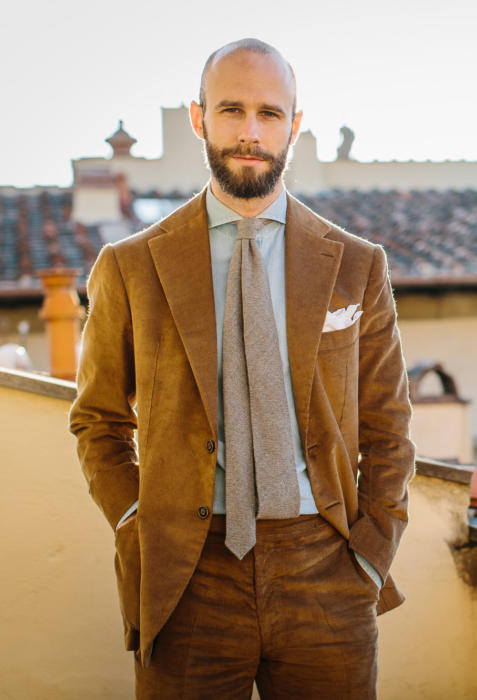
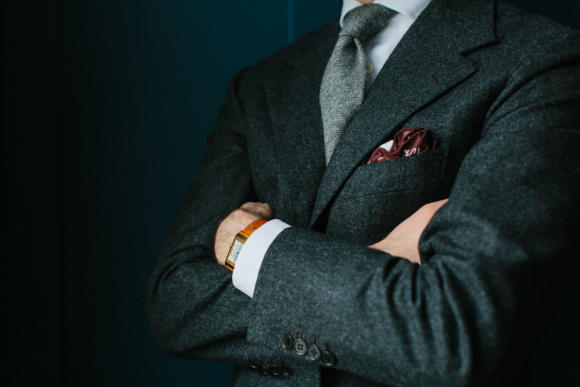
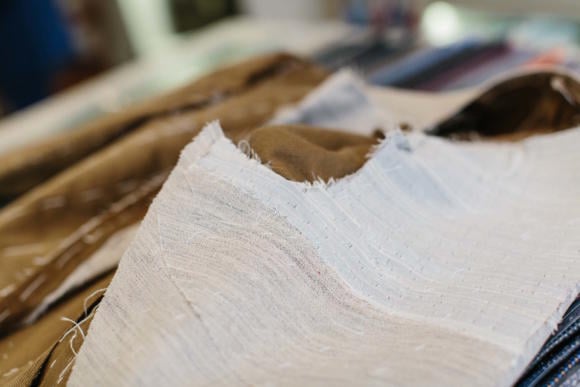
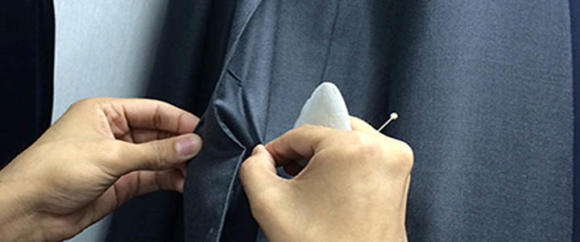
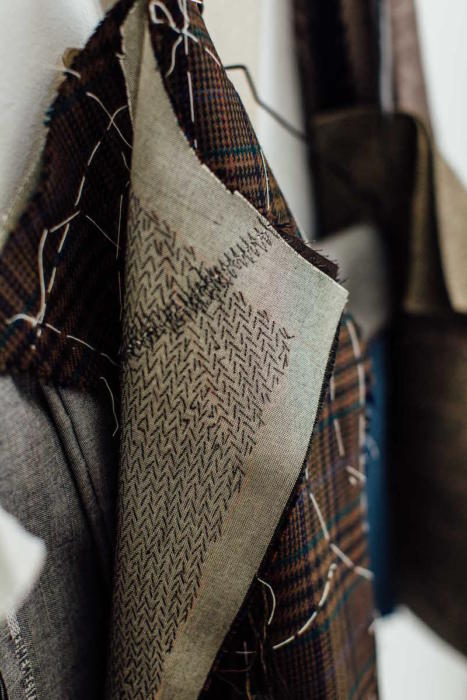
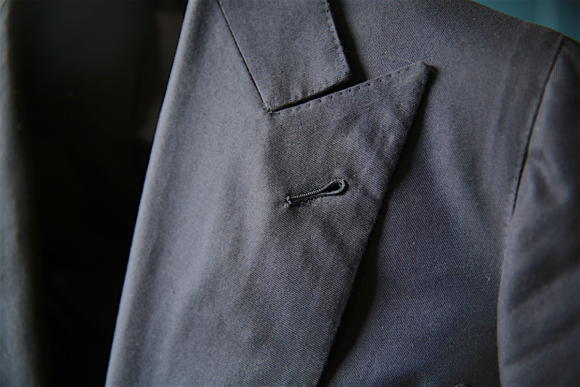
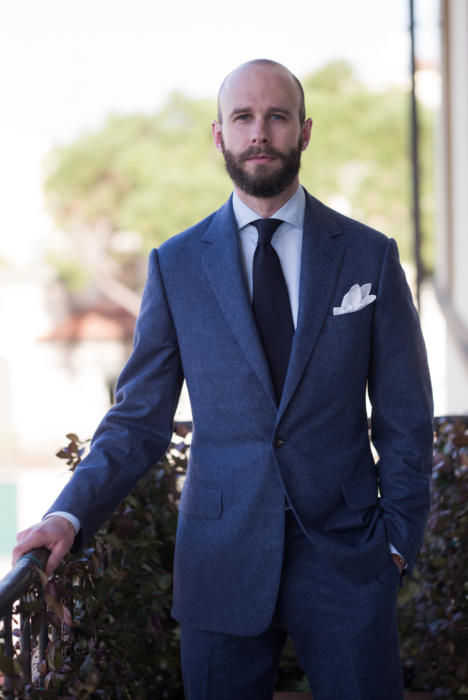


























Simon,
Top of the morning to you. My name is Benjamin Foley and I recently started working for a “modern bespoke” company by the name of Knot Standard. Prior to my beginning here, I worked in finance.
I am sure you are extremely busy, but I have been voraciously reading your blog for tips and advice on how to understand the world of bespoke menswear. Therefore, I wanted to reach out to see if you would be so kind as to give some advice on how to accelerate my learning of the industry (mills, textiles, measurement/fit, etc.). I understand you are very busy and probably get a lot of emails like this, so I understand if you are unable to reply, but I have listed a couple questions below that would be extremely helpful.
What book would you recommend to a man just beginning his journey in the bespoke world, but who wants to be immersed in the industry? (I have read Style and the Man by Alab Flusser – Looking to learn about the industry not just how to dress myself)
Are there any designers/tailors that were able to become masters of their craft later in life or at a faster pace than most?
Thank you so much for all of the work you do and I look forward to hearing from you.
Best,
Ben
Dear Simon,
Where is the best place to place the ubiquitous mobile phone inside a suit jacket?
I am about to have my third suit made by a Savile Row tailor.
I asked for a mobile phone pocket in the first two, my cutter even took a tracing of my phone to have the right dimension, but when the suits arrived — no phone pocket.
I would like to get this right the third time.
The jacket will be DB, and I wonder if it is better to have the somewhat heavy phone place high on the chest, midship, low, or whatever.
What have you found?
In the chest is usually the best place – it has the most support. Ideally high up so it doesn’t run into the waist of the jacket, and with the pocket a little shallower and narrower than normal, so the phone is reachable and doesn’t fall over sideways.
Ticket pockets can also work well, as well as change pockets in your hip pockets. Again, need to make sure they are low enough not to interfere with the waist however
Hi Simon
I know this is an old post, but I thought my comments might be best placed here…
I love bespoke garments and the process surrounding it and have had three suits made as well as a few made-to-measure items.
Obviously a few friends noticed this and were keen to have a bespoke suit made as well. The two friends who went to Savile Row tailors came back extremely dissapointed.
One of them is unhappy with the shape of the suit, the other one complained that the fit is too constricting . I know…obviously it is up to them to raise the issues with the tailor and and to explain on what they expect from a suit. Still, I sympathise with them as this mirrors my first experience as well.
I agree with your article above, that the quality of bespoke suits can be outstanding. However, I’d argue, that it ultimately comes down to fit and style. One cannot expect from new customers to be an expert in all the details of such house-styles, shoulder structures, drape, etc. I would expect the sales-person in the store to be able to identify the client’s Level of knowledge and to be able to properly guide the client and to point out what to expect from the finale product. I don’t feel the staff is properly trained to do so, which is a massive let-down for people who weren’t prepared to spend weeks on reading books/blogs, etc.
Hence, my question: Have you ever considered the idea of offering some sort of bespoke consultancy service? Basically to individually guide potential clients through the various house-styles, pros/cons depending on body shape, differences in terms of quality, etc. Basically everything PS offers but more tailored towards the individual? Maybe an idea for your next pop-store?
Hi Philipp,
I agree, this is one of the biggest issues for bespoke tailors today. They aren’t set up to communicate to a first-time shopper what the final suit will look like (more examples of suits to try one needed there) and just don’t make it a comfortable enough environment that those customers can bring up their issues or thoughts.
But to your question, yes this is actually something I already do. I don’t talk about it much, but it’s mentioned on my personal site, simoncrompton.co.uk. I’ve worked with half a dozen people in the past year to help them through this, and it does prove to be very helpful.
If you think any friends would find it helpful too, do tell them to get in touch.
Thanks
Simon
Hi Simon,
I had a question which most bespoke and quality oriented blogs like yourself do not address.
I live in india and 3 months is really hot and humid. If I am in the factory I like to wear cotton pants.
Keeping this in mind I saw ordered one cotton trouser each, with fabric from zegna and loro piana(SOLBIATI). Is there something I should keep in mind with regards to cotton trousers or is there a brand which you suggest.
Do you mean you want a brand of material, such as Zegna and Solbiati? Or a brand of ready-to-wear trouser?
To be honest, I would say that if you want to stay elegant in such heat, go for linen trousers rather than cotton. They’ll look better and be cooler.
Also, if you do want cotton trousers, and they’re for working in all day, perhaps avoid the luxury mills like the ones you mention. They’re much dressier cottons and often not that hard wearing.
I found that fabric from Zegna loses its sheen over wash and iron. Solbiati was a little thick for the summers but is really nice feel. So you are right cotton has been a hit and miss from luxury mills. I was thinking of picking up one cotton fabric from ariston but I might put that off.
Linen gets crumpled very easily. Is there something you would suggest.
Perhaps try the starchier, Irish linens? From someone like W Bill or Holland & Sherry. Rather than Solbiati
on a seperate but related topic, you have to try Greenhills from VBC.
I got suit made from it two years ago and now I wear the trouser regularly(halflined). It is literally the most comfortable pant ive ever worn.
Dear Simon,
My name is Hyunook and I live and work in Seoul, Korea.
I was wondering if I could seek your wisdom and experience with purchasing men’s clothing, in particular suits and other articles of clothing?
I am an avid reader of permanent style and the articles and videos on the site are uniquely informative, brilliantly written and particularly useful. Your articles have changed my entire outlook on men’s clothing.
With that in mind, I was wondering if I could disturb you with a few questions to better help guide future purchasing decisions?
One thing I struggle with is making an informed decision about value for money in terms of quality. I was wondering if I could disturb you with a few questions?
1. What tailoring houses make the most durable suits in your opinion?
Weight of cloth, type of fiber, frequency of wear, weave and so on are all very important and I learned tremendously about these points through Permanent Style but the ‘quality of the make’ seems important as well, especially given the investment (Please correct me if I am wrong).
2. What clothing brands make some of the most durable clothes in your opinion?
What are some of the clothing brands you love that gave you the most wear over the years? Although purchasing new items of clothing is one of the great joys in life, maintaining a sensible, durable and reliable wardrobe is both desirable in terms of quality and good value for money.
3. What do you think of Church’s Crown Collection?
Would you say it is on the same level as Edward Green, John Lobb or Gaziano and Girling?
I haven’t found much on Church’s Crown Collection and was wondering what you thought of them.
I am very grateful for your incredible generosity in sharing your knowledge and sartorial journey.
Hi Hyunook,
1.
The choice of tailoring house won’t make much difference to how long the suit lasts. As long as it is decent quality, and you are able to take the suit back to that tailor, or send it to them, for repairs when needed, then it should not be a concern. Cloth is far, far more important. And buying two pairs of trousers!
2.
Again, I wouldn’t say it’s about the brand. It’s about the piece of clothing. For example, a linen trouser from Drake’s won’t last anywhere near as long as a heavy winter cotton one. And neither will last as long as jeans. Do let me know if you have more specific questions in that area.
3.
I haven’t tried them myself, but I’ve seen them and read about them. They look similar to those other brands in terms of make and leather, but I would still err towards the non-Church’s ones if I had the choice. Mostly because I have long experience of the others, and can vouch for their quality.
Thank you so much for the prompt response. Your insights are priceless!
Hello, Simon! Ștefan here, bringing (and expanding upon) a question from Instagram about suit linings. In short: Are all fused linings created equal? The long question contains a story. I recently had my first bespoke jacket made at a local tailor (with great experience – around 70 years old) in Bucharest. At the first fitting, I noticed the lack of hand sewn canvas I had seen on all bespoke basted fitting pictures over the web, and the presence of a gray fused interlining. The second fitting, I addressed this – the reason the tailor gave for using that kind of construction was weight. Now, the jacket I did receive has the following characteristics: lapel roll, smooth chest (no disadvantageous break in the lapel), heavy feel (heavier than any jacket I have, certainly, despite using a 224 g/sqm fabric). What other disadvantages could I encounter in the years to come, as I wear the jacket? I heard of bubbling around the edges of the coat, but could a good quality glue not have the same effect?
I hope my question is not too convoluted to answer, Simon. I have followed menswear sources for some time and I never quite understood exactly why full-canvas is better than fused – but I thought you would be best equipped to answer. Cheers!
Hi Stefan,
No worries at all, happy to help.
First off, you’re confusing different types of canvas here:
– Full canvas: This is the opposite of half canvas. It merely says whether the canvas runs down the whole front of the jacket, or only half way
– Fused canvas: The is the opposite of floating canvas. It means whether the canvas is stuck to the front of the suit, or sewn around the edges
– Hand sewn canvas: This is both full and floating, but it is also shaped by hand with padding stitches
No bespoke suit should have a fused canvas. If that is what it was, then I’m afraid you have been missold.
However, they can have a floating, non-hand sewn canvas. This is better, if it is what it is.
So, it might not be bespoke. However, there are certainly better and worse fusings, and the better ones are much less likely to bubble or react like that when wet. Unfortunately you won’t be able to tell that for a good while.
The other disadvantages are smaller, but basically a fused canvas means the front of the jacket has less movement, is less natural in how it drapes, and while it may have a roll, that won’t change or flow easily.
But again, it depends what you actually have
Thank you for your reply, Simon! The distinction you made between the *amount* of canvassing and the *method* of attaching the interlining to the fabric makes things much, much clearer – thank you! Upon closer inspection, I think what I have is a half, floating canvas. Towards the bottom of the jacket, I can’t feel a third layer in between the exterior and interior of the jacket. I feel the exterior layer as being a bit thicker, but that may be just me. Near the lapel and chest pocket, I can definitely feel three layers, and the middle one seems to be ‘floating’.
As I did not see hand stitching at the first fitting and I also did not pay a fortune for the jacket, I suppose that must be it – floating, but not hand sewn. Thank you for clearing things up!
No problem Stefan. It does sound like that’s what you have, and that it’s more good made to measure rather than bespoke
In terms of quality, it is very very likely that things are as you said . In terms of process, I would say it is closer to bespoke. The tailor does not make a separate pattern for me – not because he modifies an already existing one, but because he doesn’t work with patterns at all (I have seen him working). Also, I had three fittings and I was in full control (well, you know, in the margins of his skill and possibilities) of the garment being created. In this specific sense I think it’s closer to bespoke. For what I am paying, though, I cannot expect all the Savile Row bells and whistles.
Thanks Stefan, sounds like the fit side of bespoke but not the make. Still very good I’m sure
Thank you too! I am in the clear about what i am getting now. It feels good to be an informed customer :).
Hi Simon,
This certainly is an old topic, but I feel it is the right place to ask you my question.
What are your thoughts about half-canvas construction ?
Is it merely a marketing trick to sell a “sartorial” garment while saving costs ?
Is it a way to make a lighter jacket (say for summer) ?
The real question being : is it worth investing in half-canvassed suits and jackets or is it better to go directly towards a full-canvas construction ?
As I am strating my sartorial journey and education, but also limited by my finances as I fairly recentrly started working, I wonder if my acquisitions (mostly SuitSupply) will last, and how to keep adding new pieces.
Maybe you’ve gone into more details on another article, in which case I’m sorry, but I haven’t found it.
Thanks in advance
P.A.
Hi PA,
No worries. No thread on PS ever dies!
Half canvas is often used by brands to save money. And while it does save weight, a good quality jacket can use a very lightweight canvas, such that you won’t notice the difference.
But at the same time, it is still a fairly rough guide when it comes to quality. Because a cheaper brand just can’t afford finer canvases often, so a half canvas might be the better option for them.
I’m sure your SuitSupply ones will last, but I would try to get to fully canvas if you can.
I hope that helps
Thanks Simon for your quick answer !
I actually managed to get a discontinued jacket from Suitsupply, 3 roll 2, full-canvas, silk-linen-cashmere and pearl buttons. The canvas is fairly light, 2 layers I reckon.
I am considering on getting a Custom made suit from them, and was wondering if it was worth it to get the full canvas for an extra 100€.
Given your answer, I think I will go with that option.
By the way, I know that this is not really Permanent Style’s bracket, but do you have by any chance any recommendations on affordable and (relatively) good quality MTM/RTW brand in the Suitsupply budget ?
I live in Paris by the way, so I have access to both physical and online stores.
Cheers
P.A.
Sounds good Paul, and yes I’d agree it’s worth it.
But I’m sorry, you’re right I don’t really have anything to recommend in that area.
Hi Simon, if the jacket is half canvassed, does that mean the rest must be fused?
For instance, given that you did collaborate work with Drakes back in 2017, do you know how they make it?
Many thanks,
Jack
Hi Jack,
No, usually it just means there isn’t any canvas in the lower half. Less of a problem with less fine materials, or cords etc as Drakes often use.
They’ve changed tailoring factories a few times though, I’m afraid, so I don’t know anything about the current make.
Hello Simon,
Thank you very much for all the research, review and photo. We really appreciate it!
After reading PS for many years, I noticed that there are some tailors that you particularly like. And there are some tailors that you don’t like as much, but you carefully selected the word so as not to sound negative, which is something I like about PS.
If the style isn’t a problem and if we only factor in customer service, craftsmanship and taste, which tailors in Savile Row, Italy and France would you strongly recommend?
I know you always try to be objective and you will say that it all comes down to personal preference. However, I think craftsmanship and skill are universal. Even if it comes down to personal preference, you commissioned more bespoke suits than anyone I know, so I would trust your personal opinion 100%.
I had two bespoke suits from a certain Savile Row tailor and I didn’t do much research about them beforehand. The first experience with them was so bad that they offered a 50% discount on my second bespoke suit. I took it but I don’t think I will go back there again.
I am looking forward to hearing from you soon and thank you very much for your time.
Hi there,
I understand your point of view. If style is not a factor, nor price, then I think the vast majority of tailors I have covered would be good. There are only a handful I’ve really felt were that negative, and I think I know who those were.
Perhaps it’s worth narrowing down your question by being more specific about other factors?
Hi Simon. Thank you very much for answering my questions. I am sorry for being vague. That’s all I need to know. Who tailored the suit that you wear in the last photo? It looks beautiful. Perhaps one of the best suit that you have.
No worries at all, W. That’s what the comments section is for, and I know it provides lots of useful info to other readers too.
The last photo is Whitcomb & Shaftesbury, RAF blue flannel. There’s a separate post on it if you look it up
Hi Simon, would you say full canvass is always better than half canvass jackets?
For instance, Drakes offer their tailoring jacket at an average of around £995 and Anglo Italian for £990. However, the only major difference is that the former offers half canvass and the latter full canvass. Which would you go for if you were not considering the aesthetic aspects?
Many thanks,
Jack
I would always want a full canvas myself, in anything intended to be smart. If it’s a casual cotton jacket, or a garment-washed linen, then that’s different
Thanks, Simon.
Writing here. I’m 22 years old, recently got into classic menswear recently. Pre 21, I was a t-shirt jeans kind of boyo. Anyways, that tip regarding the pinch test around the buttons, a massive life saver. I would get so confused by the pinch test, for instance I have a Gieves Hawkes Made in Mauritus suit. It had canvas below the pockets. So it was confusing whether it was full canvas or not. Now I can safely confirm, it’s half-canvassed. Thanks!
Simon, I am considering having a new MTM suit made. The company offers an option of having pick stitching (using a machine) or not. I am considering not having the pick stitching. Is there any disadvantage to avoiding pick stitching on lapels?
Only the look – it’s there for decoration, and really just mimics stitching that would have been done in the past by hand.
It can look nice when done finely and perhaps closer to the edge. But it can also be chunky and shiny and look cheap. Have you seen another jacket of theirs with that stitching?
Hello, Simon. Could you share your views on rear trouser pockets in business suits. I am looking for a contemporary look, one that I could wear to the office but still look practical and current.
Hi Duke,
My thoughts are in this article, part of the Guide to Suit Style
I appreciate your valuable insights. I have a little question: when tailors mention back panels and side panels, are they referring to the canvas?
No, usually to the panels of the jacket – eg there are two panels on the back, divided by the central seam
May I ask why? Anything else I can help with?
A little confusion with jacket construction. I have noticed that some coats have a visible back seam, while others do not. What are the panels in these coats usually made of, and why do some coats have a visible back seam while others do not?
Sorry, you mean the panels on the back of the jacket? They’re made of the jacket material? Maybe sending an image would help.
The back seam down the middle of the back of a jacket can be more or less prominent, if it’s made as a lap seam for instance or it has pick stitching. You can also get jackets with a one-piece back but they’re rare
Thank you.
I remember some years ago now looking at the Holland & Sherry Crystal Springs, an extremely light 7.5 oz bunch, it looked like a light shirting cloth, and the myriad colours of the swatches when a tailor said to me “ that bunch is not for you, big man…very sensible advice,I’m a six footer! It certainly would not have lasted long on me.
Yes, I did commission two pairs of trousers, one to match my navy jacket, a suit, the other a grey strong whipcord which should last a good while!
Thanks for the good advice in this post Simon!
Hi Simon,
I am absolutely loving your blog. It is such a pleasure to read about the small details and how they influence the overall craftsmanship of a garment. I have two questions.
Thank you Sterling, that’s lovely to hear.
1. I wouldn’t ever do a half canvas, as it’s possible to use very light canvases in jackets and get a really light effect, but have it all the way down the jacket. However I do realise not all those are available in RTW jackets at all prices. I would do a lighter canvas on a lighter fabric though, assuming it was in keeping with the style of the tailor (eg a more structured cut generally benefits from a little extra structure).
Unstructured jackets with no canvas I certainly like for something more casual – we discussed them here.
2. Yes I would do it full canvas, for the reasons described above. Just a lighter weight one
Thank you Simon, this helps a ton.